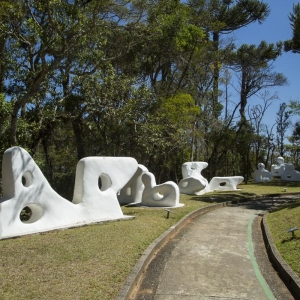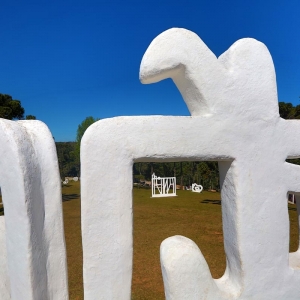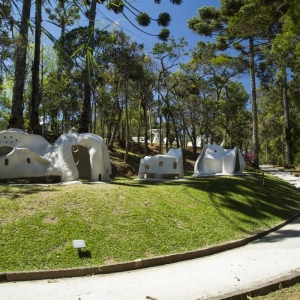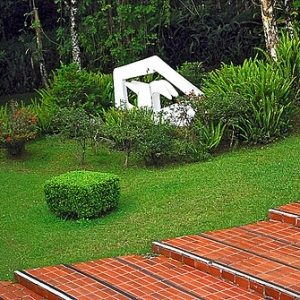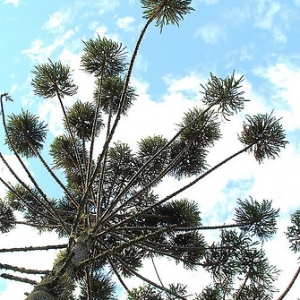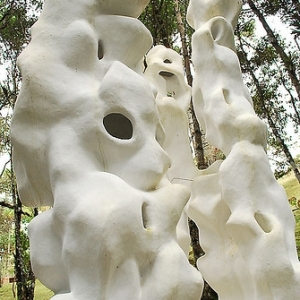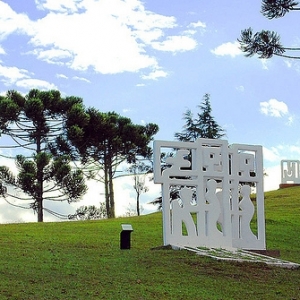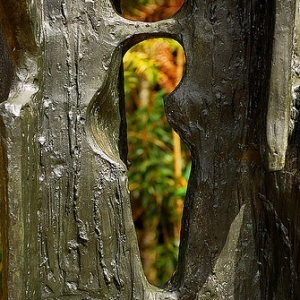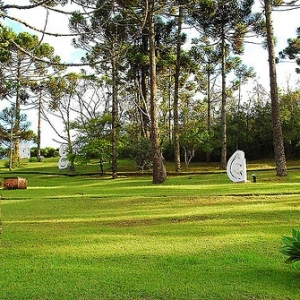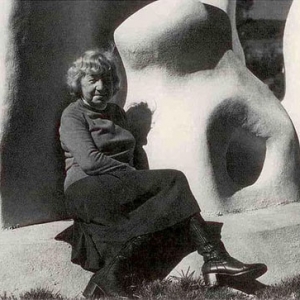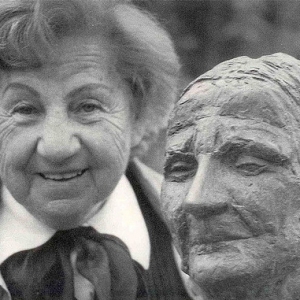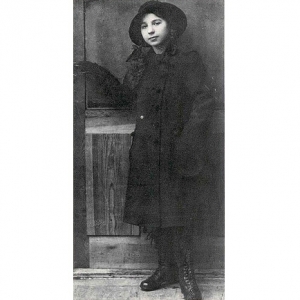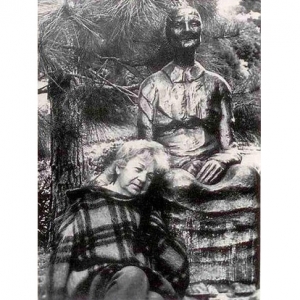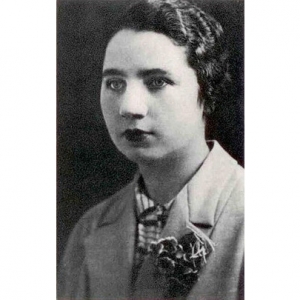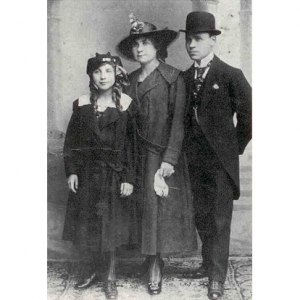The Felícia Leirner Museum, institution from the Government of the State of São Paulo, managed by the Secretariat of Creative Culture, Economy and Industry from the State of São Paulo in a partnership with ACAM Portinari – Cultural Social Organization, opened in 1979, in Campos do Jordão, and was made official in 2001 by State Decree n. 46.466.
Located in a 35 thousand m² wooded area, the museum brings together a set of 88 works made bronze, white cement, granite and plaster, by the artist Felícia Leirner, distributed in the open air, on the garden of the space shared with the Claudio Santoro Auditorium, home of the International Winter Festival.
The works shown in the garden follow the artist’s criteria, the sculptures are grouped according to the phases of Felícia’s trajectory: figurative (1950-1958), on the way to abstraction (1958-1961), abstract (1963-1965), organic (1966-1970) and landscape clippings (1980-1982).
The set of works reveals the artist’s passion for nature and for the location, which has been considered one of the most important of the genre in the world by Sculpture Magazine, of the International Sculpture Center, in Washington D.C. (USA), in 1987.
Mission
The Felícia Leirner Museum and Claudio Santoro Auditorium’s mission is to preserve, research and communicate their sculpture collection; to promote fruition and expression in visual arts, especially in sculpture; to stimulate appreciation, understanding and musical expression; to preserve the vegetation of their garden, intrinsically associated with the collection of sculptures, and their adjacent area of Atlantic Forest, and promote environmental conservation, contributing to the building of dialogues and bridges for knowledge.
Vision
The Felícia Leirner Museum aims to be a national and international reference, among museums that combine cultural and natural heritage in the same space, and to be relevant as a center for the promotion of visual arts, especially sculpture, music, performance in environmental sustainability, with attention to social welfare in its management and services.
Values
∙ Safeguarding and communicating cultural and natural heritage with responsibility and quality.
∙ Respect for life and people without distinction by individual characteristics. Responsibility for human development and promotion of diversity and inclusion.
∙ Performance in local and global environmental sustainability.
∙ Quality management, based on valuing professionals and other social agents involved in its processes, to satisfy the institutional mission and vision.
∙ Ethics, economy and transparency in the use of public and private resources.
Felícia
Leirner
Felícia Leirner was born in 1904 in Warsaw, Poland. She moved to Brazil in 1927, and in 1962 she exchanged the city of São Paulo for Campos de Jordão, in search for a life closer to nature.
In 1978, Felícia intensified her work and inaugurated the Felícia Leirner Museum. In 1982, she concluded her production for the Museum.
“My process consists of arranging, messing it up, cutting, piecing it all togheter again, pierce holes in paper, cloth and everything that is within my reach, tidying up, messing up, modifying. And, after all of that, everything that I have felt and modified was worthwhile.”. – Felícia Leirner
At home, she continued to pass her time with embroidery, drawing, writing and creating smaller clay pieces, which were then cast in bronze, mostly in the shape of birds. Felícia Leirner died in 1996, at 92 years old, at her home in São Paulo.
After donating several works, the sculptor attached her name to the history of Campos do Jordão and of Brazilian visual arts.
Among her main awards are the Acquisition of the Museum of Modern Art of Rio de Janeiro in 1955 and the prize of Best Brazilian Sculptor during the São Paulo Biennial in 1963. In 1957 her sculptures were incorporated into the collections of the Museum of Art of São Paulo (Masp) and the Museum of Modern Art of Paris (Centre Pompidou) in France.
Other international collections have also hosted her works, such as the Hermitage in Russia, Royale de Belgique in Belgium, Ein-Hod in Israel, and the Modern Gallery of Belgrade in Serbia.
Cronologia
Felícia Leirner is born in the city of Warsaw, Poland.
He migrates to Brazil, a country he adopts as a homeland.
At the age of 44, he began his sculpture studies with renowned artist Victor Brecheret.
His first works belong to the Figurative phase.
It confirms his importance as an artist when he participates in the international biennials of São Paulo. In 1955 she was awarded the Acquisition Award from the Museum of Modern Art in Rio de Janeiro. At that time, his work obtained important national and international recognition.
His sculptures are incorporated into the collections of the São Paulo Museum of Art (MASP) and the Museum of Modern Art in Paris, followed by other important museums in Europe, such as the Stedelijk Museum in Amsterdam and the Tate Gallery, in London, which also add Felícia’s works to her collections.
Already established, he enters a new stage of his art and his works become abstract.
Shaken by the early death of her husband Isai Leirner, she moves from São Paulo to Campos do Jordão, where she houses her sculptures until 1978, when they are transferred to the newly created Felícia Leirner Museum.
The “Cruzes” (1963) phase begins, followed by “Structures” (1964/1965). His work continues to be recognized in Brazil and abroad. In Biennials VIII, IX and X, he exhibits in Special Rooms. The Correio do Brasil newspaper issues a commemorative stamp for the 10th Biennial, choosing a sculpture by Felícia to illustrate it. Other world-renowned museums, such as the Hermitage (Russia), the Royale de Belgique (Belgium), the Ein-Hod (Israel) and the Modern Gallery of Belgrade, also host their works.
The Bienal de São Paulo grants the artist the award for Best Brazilian Sculptor.
Always in search of new forms and materials, he leaves clay, bronze, granite and begins to produce large pieces in white cement, aided by workers from the region. This is the starting point for the “Habitacles” phase (1966), in which one embarks on the territory of architecture, with habitable sculptures.
The “Bichos” phase begins, a curious and fantastic zoo in many ways. At the same time, he conceived a large ensemble dedicated to “Man and the Family”, a large work (almost 8 meters long by 3 meters high), also executed in granite, which is found in the gardens of the Palácio dos Bandeirantes seat of the Government of the State of São Paulo. He also started to execute the great “Columns”, full of cavities, where rainwater could accumulate and cool birds, animals for which he always showed special affection. Emblematic of this phase is the “São Francisco”, with open arms awaiting the visit of the birds.
His love for nature and Campos do Jordão came true with the creation of the Felícia Leirner Museum by the Government of the State of São Paulo. All the works of her authorship and her property were donated by the sculptor to the newly created museum.
Official opening of the Felicia Leirner Museum.
Felícia Leirner continues her work, producing works within the museum itself. It is the phase of the “Portals”, with cut, flat shapes, which are distributed over the landscape as enigmatic messages.
It frames a crooked tree in the garden with its sculpture. It is the end of his production at the museum. From that moment, he retired to his home in Campos do Jordão, where he continues to be distracted by his talents as always. Embroider, make rugs, draw and write. Felícia continued to produce smaller clay sculptures, which were later cast in bronze. Almost all of them depicted birds.
Felícia Leirner passes away at the age of 92, quietly, in her house of São Paulo.







